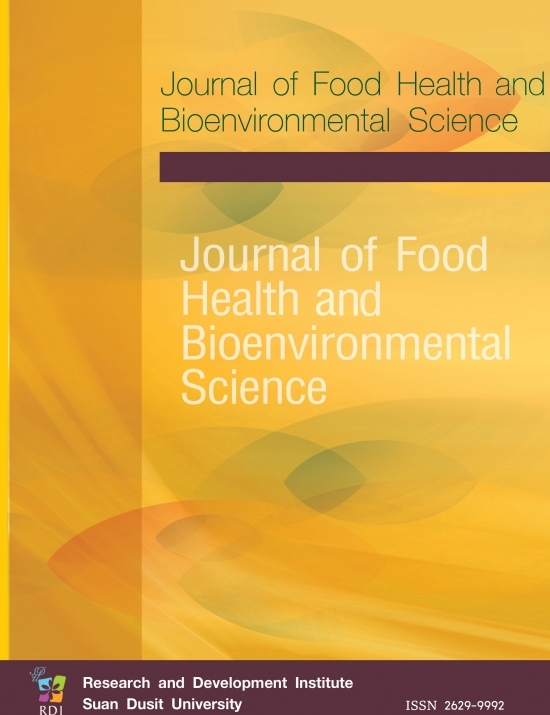Utilization of Pineapple Residue for Pineapple Paste and Gluten-free Pie
Keywords:
Pineapple Residue, Pie, Gluten-freeAbstract
This research was conducted to optimize the formula to produce pineapple paste and gluten-free pie products. The seven formulas of the pineapple paste consisting of pineapple residue (70-100%), pineapple juice (0-30%) and sugar (0-30%) were studied using Mixture Design. The properties and sensory evaluation by untrained panelists were investigated. The results showed that the pH of pineapple paste tended to decrease when the amount of pineapple juice increased. Apparently, the total soluble solid and brightness of pineapple paste varied directly as the amount of sugar. An appropriate formula of pineapple paste was 75% pineapple residue, 5% pineapple juice and 20% sugar, respectively. This formula had the highest score for all attributes. Next, the nine formulas of gluten-free pie products consisting of mixed flour (60-70%), salted butter (20-40%) and pineapple residue (0-10%) were studied using Mixture Design. The properties and sensory evaluation by untrained panelists were investigated. The results indicated that weight loss of pies varied directly with the amount of butter. The hardness and the brightness of pies varied directly with the amount of mixed flour. Obviously, a suitable formula of gluten-free pie product was 70% mixed flour, 20% salted butter and 10% pineapple residues, respectively. This formula had the highest score for all attributes. In conclusion, utilization of pineapple residue helps provide value-added on agricultural by-products in gluten-free foods.
References
AOAC. (2000). Official Methods of Analysis of AOAC International (17th ed.). Maryland, USA: AOAC International.
Chalermsan, N., Boonda, P., Navanukraha, B., & Jaree, T. (2011). The effects of using fermented pineapple bran in diets on production performance, carcass quality and meat quality in broilers. Journal of Community Development Research, 4(1), 52-63.
Charoenphun, N., & Kwanhian, W. (2018). Effect of flour from durian waste on quality of gluten free pasta. Thammasat Journal of Science and Technology, 26, 803-814.
Duncan, D.B. (1995). Multiple range and multiple F tests. Biometrics, 11, 1–42.
Erge, H.S., Karadeniz, F., Koca, N., & Soyer, Y. (2008). Effect of heat treatment on chlorophyll degradation and color loss in green peas. GIDA, 33, 225-233.
Ikegaya, A., Toyoizumi, T., Ohba, S., Nakajima, T., Kawata, T., Ito, S., & Arai, E. (2019). Effects of distribution of sugars and organic acids on the taste of strawberries. Food Science & Nutrition, 7, 2419–2426.
Khoury, D.E., Balfour-Ducharme, S., & Joye, I.J. (2018). A review on the gluten-free diet: technological and nutritional challenges. Nutrients, 10, 2-15.
Kotoki, D., & Deka, S.C. (2010). Baking loss of bread with special emphasis on increasing water holding capacity. Journal of Food Science and Technology, 47, 128-131.
Luangsakul, N., Katekasem, P., Suksawang, M., & Pornanansiri, S. (2012). The effects of the amount and type of wheat flour and mixing method on the quality of fortune cookies. Retrieved from http://www.lib.ku.ac.th/KUCONF/2555/KC4906034.pdf.
Majidi, H., Minaei, S., Almasi, M., & Mostofi, Y. (2011). Total soluble solids, titratable acidity and repining index of tomato in various storage conditions. Australian Journal of Basic and Applied Sciences, 5(12), 1723- 1726.
Mapaya, T., Kruapala, P., Deesanam, N., & Taivejchasat, S. (2016). Product development of adding crude fibers pineapple on chicken sausage. In The12th Naresuan Research Conference (pp. 279-289). July21-22, 2016. Naresuan University. Phitsanulok. Thailand
Moskowitz, H.R., Beckley, J.H., & Resurreccion, A.V.A. (2012). Sensory and consumer research in food product design and development. New Delhi. India: Wiley-Blackwell.
Office of agricultural economics. (2018). A study on pineapple supply chain and logistics management. Bangkok.
Paine, L. (2013). Growing the Pasture-Grazed Dairy Sector. Retrieved from https://foodsci.wisc.edu/pasture_grazed_dairy/assets/Pasture%20Milk%20and%20Product%20Color.pdf.
Panyamongkol, S. (2017). The relationship between physical and chemical properties in poolae pineapple with maturity stage among number 0-7. Kasalongkham Research Journal, 11(3), 49-59.
Pongjanta, J., Nualbunruang, A., Panchai, L., & Buaphan, T. (2011). Organic acids and sugar changes in pineapple juice (Ananas comosus cv. Smooth Cayenne) from different location planted and ripen degree. In The 49th Kasetsart University Annual Conference (pp. 267-274). February 1-4, 2011. Kasetsart University. Babgkok. Thailand
Rattanapanone, N. (2006). Food chemistry. Bangkok: Odeon Store.
Surojanametakul, V. (2013). Coeliac disease and the importance of gluten-free foods. Food Journal (Thailand), 43, 16-21.
Susirirut, P., Vibulsresth, P. & Chaiwut, P. (2013). Properties of body scrub containing pineapple (ananas comosus l.) fiber. Retrieved from http://lib3.dss.go.th/fulltext/techno_file/CF96/CF96(B4).pdf.
Thai industrial standards institute. (2012). Thai community product standard (Pies and Tarts) 524/2555. Retrieved from http://app.tisi.go.th/otop/standard/standards.html.
Thamkaew, T., & Susirirut, P. (2017). Formulas development of body spa products from pineapple (Ananas comosus L.) fiber. (Research reports). Dhurakij Pundit University.
Utama-ang, N., & Tepjaikad, T. (2001). Extraction of dietary fiber from pineapple residue and utilization. In The 39th Kasetsart University Annual Conference (pp. 395-401). February 5-7, 2001, Kasetsart University. Babgkok. Thailand
Downloads
Published
How to Cite
Issue
Section
License

This work is licensed under a Creative Commons Attribution-NonCommercial-NoDerivatives 4.0 International License.








